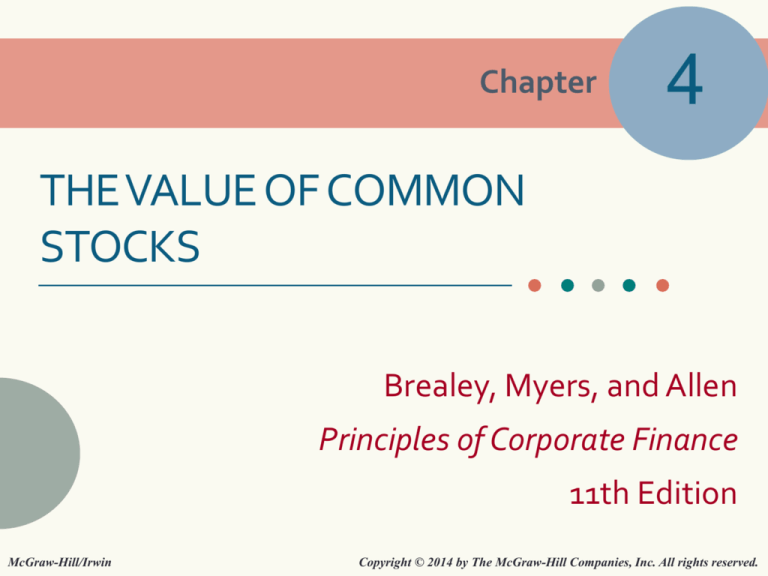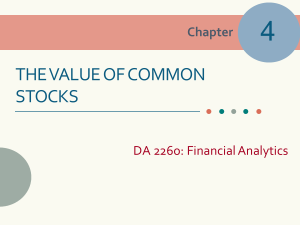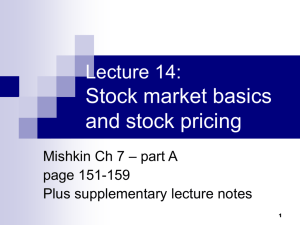
Chapter
4
THE VALUE OF COMMON
STOCKS
Brealey, Myers, and Allen
Principles of Corporate Finance
11th Edition
McGraw-Hill/Irwin
Copyright © 2014 by The McGraw-Hill Companies, Inc. All rights reserved.
4-1 HOW COMMON STOCKS ARE TRADED
• Primary Market
• New securities
• Secondary Market
• Previously-issued securities
• Common Stock
• Ownership shares in publicly-held
corporation
4-2
4-1 HOW COMMON STOCKS ARE TRADED
• Electronic Communication Networks
(ECNs)
• Computer networks that allow electronic trading
• Exchange-Traded Funds (ETFs)
• Stock portfolios bought/sold in single trade
• SPDRs (Standard & Poor’s Depository
Receipts or “spiders”)
• ETFs tracking several S&P indexes
4-3
4-2 HOW COMMON STOCKS ARE VALUED
• Book Value
• Net worth of firm according to balance sheet
• Dividend
• Periodic cash distribution from firm to the
shareholders
• P/E Ratio
• Price per share divided by earnings per share
• Market Value Balance Sheet
• Financial statement that uses market value of
assets and liabilities
4-4
4-2 HOW COMMON STOCKS ARE VALUED
• Discounted Cash Flow (DCF) Formula
• Value of a stock = present value of future cash
flows
PV(stock) PV(expecte d future dividends)
4-5
4-2 HOW COMMON STOCKS ARE VALUED
• Expected Return
• Percentage yield forecast from specific
investment over time period
• Sometimes called market capitalization rate
4-6
4-2 HOW COMMON STOCKS ARE VALUED
• Example
• Fledgling Electronics sells for $100 per share
today; they are expected to sell for $110 in one
year. What is expected return if dividend in one
year is forecasted to be $5.00?
5 110 100
Expected return
.15
100
4-7
4-2 HOW COMMON STOCKS ARE VALUED
• Price of share of stock is present value of
future cash flows
• For a stock, future cash flows are dividends
and ultimate sales price
Div1 P1
Price P0
1 r
4-8
4-2 HOW COMMON STOCKS ARE VALUED
• Example
• Fledgling Electronics price
5 110
Price P0
100
1.15
4-9
4-2 HOW COMMON STOCKS ARE VALUED
• Market Capitalization Rate
• Estimated using perpetuity formula
• Also called cost of equity capital
Div 1
Capitaliza tion rate P0
rg
Div 1
r
g
P0
4-10
4-2 HOW COMMON STOCKS ARE VALUED
• Dividend Discount Model
• Computation of today’s stock price: share value
equals present value of all expected future
dividends
• H: Time horizon for investment
Div1
Div 2
Div H PH
P0
...
1
2
H
(1 r ) (1 r )
(1 r )
4-11
4-2 HOW COMMON STOCKS ARE VALUED
• Modified Formula
Div1
Div 2
Div H PH
P0
...
1
2
H
(1 r ) (1 r )
(1 r )
H
Div t
PH
P0
t
H
(1 r )
t 1 (1 r )
4-12
4-2 HOW COMMON STOCKS ARE VALUED
• Example
• Fledgling Electronics forecasted to pay $5.00
dividend at end of year 1 and $5.50 dividend at
end of year 2. End-of-second-year stock will be
sold for $121. Discount rate is 15%. What is the
price of stock?
5.00
5.50 121
PV
1
2
(1 .15)
(1 .15)
PV $100.00
4-13
4-2 HOW COMMON STOCKS ARE VALUED
• Example
• XYZ Company will pay dividends of $3, $3.24,
and $3.50 over next three years. After three
years, stock sells for $94.48. What is the price
of stock given 12% expected return?
3.00
3.24
3.50 94.48
PV
1
2
3
(1 .12) (1 .12)
(1 .12)
PV $75.00
4-14
4-2 HOW COMMON STOCKS ARE VALUED
4-15
4-3 ESTIMATING COST OF EQUITY CAPITAL
• Dividend Yield
• Expected return on stock investment plus
expected dividend growth
• Similar to capitalization rate
Div1
Price P0
rg
Div1
Dividend yield r
g
P0
4-16
4-3 ESTIMATING COST OF EQUITY CAPITAL
• Example
• Northwest Natural Gas shares sold for $47.30
at start of 2012. Dividend payments for 2013
were $1.86 a share with no growth. What is
dividend yield?
Dividend Yield r
1.86
r
47.30
r .039
4-17
4-3 ESTIMATING COST OF EQUITY CAPITAL
• Example
• Northwest Natural Gas shares sold for $47.30 at
start of 2012. Dividend payments for 2013 were
$1.86 a share with 6.1% growth. What is dividend
yield?
Dividend yield r
1.86
r
.046
47.30
r .085
4-18
4-3 ESTIMATING COST OF EQUITY CAPITAL
• Return Measurements
Div1
Dividend yield
P0
Return on Equity ROE
EPS
ROE
Book equity per share
4-19
4-3 ESTIMATING COST OF EQUITY CAPITAL
• Dividend Growth Rate
• Derived by applying return on equity to
percentage of earnings reinvested in operations
• g = return on equity × plowback ratio
4-20
4-3 ESTIMATING COST OF EQUITY CAPITAL
• Valuing Non-Constant Growth
Div1
Div 2
Div H
PH
PV
...
1
2
H
H
(1 r ) (1 r )
(1 r )
(1 r )
Div H 1
PH
rg
4-21
4-3 ESTIMATING COST OF EQUITY CAPITAL
• Example
• Phoenix pays dividends in three consecutive
years of 0, .31, and .65. Year-4 dividend is
estimated at .67 with perpetuity growth at 4%.
With 10% discount rate, what is stock price?
1
0
.31
.65
.67
PV
1
2
3
3
(1 .1) (1 .1) (1 .1) (1 .1) (.10 .04)
9.13
4-22
4-4 STOCK PRICE AND EARNINGS PER SHARE
• If firm pays lower dividend and reinvests
funds, stock price may increase due to
higher future dividends
• Payout Ratio
• Fraction of earnings paid out as dividends
• Plowback Ratio
• Fraction of earnings retained by firm
4-23
4-4 STOCK PRICE AND EARNINGS PER SHARE
• Example
• Company plans $8.33 dividend next year (100%
of earnings). Investors will get 15% expected
return. Instead, company plows back 40% of
earnings at firm’s current return on equity of
25%. What is the stock value before and after
plowback decision?
4-24
4-4 STOCK PRICE AND EARNINGS PER SHARE
• Example, continued
• No Growth
8.33
P0
$55.56
.15
• With Growth
g .25 .40 .10
5.00
P0
$100.00
.15 .10
4-25
4-4 STOCK PRICE AND EARNINGS PER SHARE
• Example, continued
• Stock price remains at $55.56 with no earnings
plowed back
• With plowback, price is $100.00
• Difference is called present value of growth
opportunities (PVGO)
PVGO 100.00 55.56 $44.44
4-26
4-4 STOCK PRICE AND EARNINGS PER SHARE
• Present Value of Growth Opportunities
(PVGO)
• Net present value of firm’s future investments
• Sustainable Growth Rate
• Steady rate at which firm can grow: plowback
ratio x return on equity
4-27
4-5 VALUING A BUSINESS
• Valuing a Business or Project
• Usually computed as discounted value of FCF
to valuation horizon (H)
• Valuation horizon sometimes called terminal
value and calculated like PVGO
PV
FCF1
FCF2
FCFH
PVH
...
(1 r )1 (1 r ) 2
(1 r ) H (1 r ) H
4-28
4-5 VALUING A BUSINESS
• Valuing a Business or Project
FCF1
FCF2
FCFH
PVH
PV
...
1
2
H
H
(1 r ) (1 r )
(1 r )
(1 r )
PV (free cash flows)
PV (horizon value)
4-29
4-5 VALUING A BUSINESS
• Example
• Given cash flows for Concatenator
Manufacturing Division, calculate PV of nearterm cash flows, PV (horizon value), and total
value of firm; r = 10% and g = 6%
4-30
4-5 VALUING A BUSINESS
• Example, Continued
1 1.59
PV(horizon value)
22.4
6
1.1 .10 .06
.80 .96
1.15 1.39
.20
.23
1.1 1.12 1.13 1.14 1.15 1.16
3.6
PV(FCF)
4-31
4-5 VALUING A BUSINESS
• Example, Continued
PV(busines s) PV(FCF) PV(horizon value)
-3.6 22.4
$18.8
4-32






